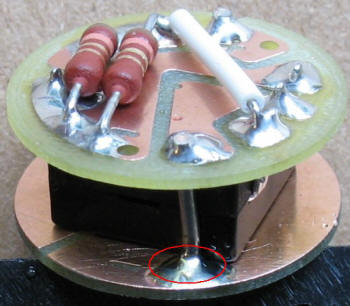All the P7 Led lights I make and use now have this simple resistor based board in them. It's so much simpler and hassle free than electronic component driver boards. I really do live by the KISS rule and Murphy's law is always in effect, so this simple driver board fits the bill for me personally.
High mode: Basically how it works is that the LED is driven direct from the battery when the switch is on the high mode.
This works fine because there is still 1/10th of an ohm or so in the whole circuit.
The batteries internal resistance, the wires, the connectors all add up to be some resistance value.
A super high current sucker like a P7 LED only needs a very tiny resistance to produce a voltage drop.
A P7 on high mode on my lights starts drawing about 3 amps, but only for a few minutes. It then drops down to 2.8 amps and then tapers off the longer you run the light.
Low: Mode: When you click the switch into low mode, two 1.3 ohm/1 watt resistors in parallel (.6 ohms total) are put in line with the battery. This drops the current to about 1.2 amps on a full charged battery pack. Half the curent is being drawn which extends the battery run time quite a while. It's half the current draw but does not appear to be half the light level to the human eye. The low mode is still very bright.
I use the low mode most of the time because most of my rides are uphill for 80% and downhill 20% of the total ride time. My night riding is all off road in the mountains of NC. I do the climbs with one light running on low and then click on everything I have when it comes time to descend down the mountain.
Bike commuters find that a P7 on high will get cars flashing their brights at them an so they may have to run the light on the low mode most of the time.
I have a bunch more info and pics of this driver board here.
http://www.el34world.com/Misc/bike/BikesLights41.htm
 http://www.el34world.com/Misc/bike/BikesLights41.htm
http://www.el34world.com/Misc/bike/BikesLights41.htm
